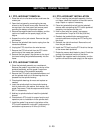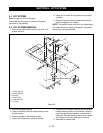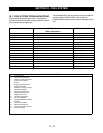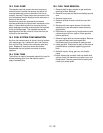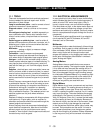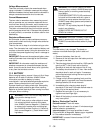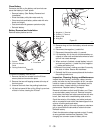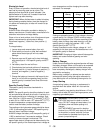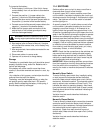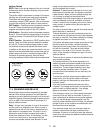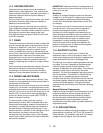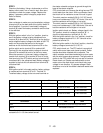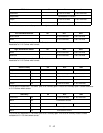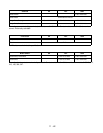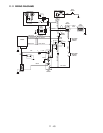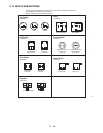
11 - 37
To jump start the battery:
1. Ensure battery is not frozen. If the fluid is frozen,
remove battery from unit and allow to thaw before
charging.
2. Connect the positive (+) jumper cable to the
positive (+) terminal of the discharged battery.
3. Connect the other end of the same jumper cable to
the positive (+) terminal of the booster battery.
4. Connect one end of the second jumper cable to the
negative (-) terminal of the booster battery.
5. Make the final jumper cable connection to the
engine block or the furthest ground point away
from the discharged battery.
6. Start engine (refer to Owner’s Manual). If engine
will not start after several tries, unit or battery may
need service.
7. After engine starts, leave cables connected for one
to two minutes.
8. Disconnect cables in reverse order.
9. Operate unit as normal to charge battery.
Storage
The battery is a perishable item and it should be stored
properly to obtain a long, useful life. Batteries not in
use will self discharge.
If the battery will not be used for more than three
months, it should be removed and stored in a cool, dry
place.
Any collection of dirt, grease, or electrolyte should be
removed from the top of the battery.
The battery must be recharged monthly or when the
cell specific gravity reads less than 1.255 specific
gravity. Before reinstalling the battery in the spring, it
should always be fully recharged.
11.4 SWITCHES
Switches either open a circuit to stop current flow or
close and allow current to flow through.
A normally open (N.O.) switch prevents current flow
until the switch is actuated, completing the circuit and
allowing current to flow through it. An example is a light
switch - the lights are off until the switch is actuated
and the lights go on.
A normally closed (N.C.) switch allows current to flow
until the switch is actuated, breaking the circuit and
stopping current flow through it. An example is an
ignition switch that grounds the magneto when in the
off position (completing the circuit) but opens the circuit
when in the ON position allowing the engine to operate.
Switches are selected with regard to Current rating
(contacts must be of sufficient size to carry the required
current), Voltage rating (switches insulated for specific
voltages), Case or housing (switches that are exposed
to moisture and must be sealed to prevent moisture
from entering), and Actuating type (push, pull, rotary,
momentary contact, or micro switches).
NOTE:
Check that the connections to the switches are
secure and that a switch is being activated properly
before performing electrical test on switches. (Safety
switches on speed selector and clutch levers may be
out of adjustment and not activating.)
IMPORTANT:
When checking switches, remove them
from their respective circuit by disconnecting the wires
from the switch at the connector(s). Damage could
result to the meter or machine components if switches
are left in.
Normally Open Switch
To test a normally open switch (key, headlight, safety,
or seat) connect the ohmmeter across the switch
terminals. Meter should indicate open circuit (infinite
resistance). Activate the switch. The ohmmeter should
read up scale to zero resistance (Close Circuit). This
indicates the switch is operating properly. Also check
from each terminal to the switch case (if case is metal).
Reading should show infinite resistance indicating no
short to ground.
Variation from test results described indicates a
defective switch.
Normally Closed Switch
To test a normally closed switch connect the ohmmeter
across the switch terminals. Meter should indicate a
closed circuit (zero resistance). Activate the switch and
the meter should move to open circuit (infinite
resistance). Check from each terminal to ground
(switch case). Meter should show open circuit (infinite
resistance).
Variation from test results described indicates a
defective switch.
WARNING:
Make sure cables are clear of any
moving engine parts before starting engine.



